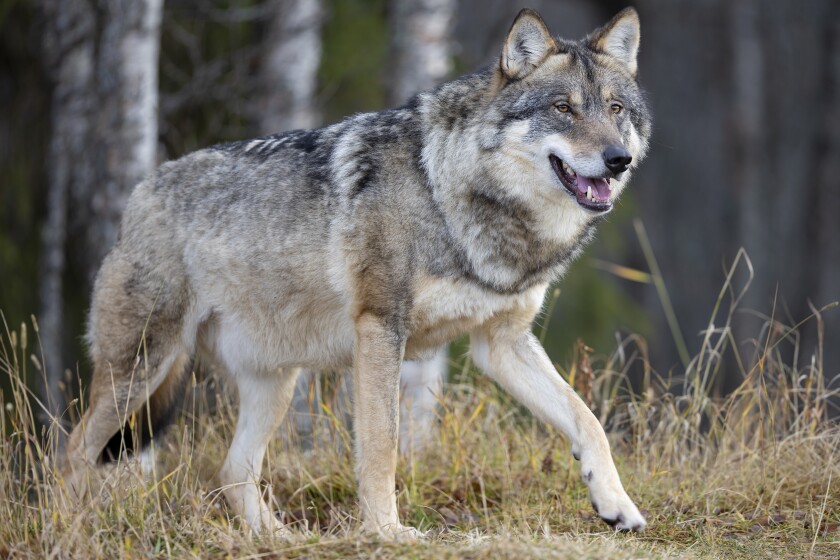SAN FRANCISCO — The Biden administration asked a federal judge to reinstate a Trump-era rule that removed Endangered Species Act protections for the gray wolf.
In an 87-page opening brief Friday in the U.S. Court of Appeals in San Francisco, U.S. Department of Justice attorneys argued that a lower federal district court erred in 2022 when it overturned the rule and reinstated the species’ protections.
ADVERTISEMENT
The attorneys wrote that the U.S. Fish and Wildlife Service’s 2020 determination that “no configuration of gray wolves was threatened or endangered in all or a significant portion of its range” was “well-reasoned and well-supported by the administrative record” and shouldn’t have been rejected.
“The district court misunderstood the (Endangered Species Act’s) clear mandate and compounded that error by imposing its own views of the science,” the government’s attorneys wrote.
Wolves first gained federal protection in the 1970s, when Minnesota was the only state in the contiguous United States to maintain a small wolf population. After their comeback across Minnesota, Wisconsin and Upper Michigan, every administration since President Bill Clinton has moved to delist wolves in favor of state control.
While there have been periods when the wolf has been delisted, efforts by federal wildlife officials to delist the wolf have been repeatedly thwarted by the courts.
Friday’s filing does not change the current legal status of gray wolves in the U.S.
Gray wolves are considered “endangered” in 44 states, “threatened” in Minnesota, and under state jurisdiction in Montana, Wyoming, portions of eastern Oregon and Washington, and north-central Utah, according to the Fish and Wildlife Service, which is part of the Department of Interior.
Fish and Wildlife Service spokesperson Vanessa Kauffman said in a statement Monday that the agency “is focused on a concept of recovery that allows wolves to thrive on the landscape while respecting those who work and live in places that support them” and pointed to a settlement agreement reached
ADVERTISEMENT
“The Department of the Interior remains steadfastly committed to the protection, preservation and longevity of gray wolves,” Kauffman said. “We recognize that this work must go beyond the Endangered Species Act to facilitate a durable and holistic approach to wolf recovery.”
Defenders of Wildlife, one of the environmental groups that had successfully challenged the Trump administration’s rule, said removing protections now could reopen wolf hunting and destabilize populations.
“Wolves have made monumental progress toward recovery but have yet to re-establish sustainable populations in much of the available habitat across the Lower 48,” Ellen Richmond, senior attorney at Defenders of Wildlife, said in a news release Monday. “Delisting at this time would set us on a backward trajectory, imperiling the species before it’s made a full recovery.”
The group was joined by the Center for Biological Diversity and the Humane Society of the United States, among other groups, in challenging the Trump-era rule.
Meanwhile, like the Fish and Wildlife Service, the state of Utah, the National Rifle Association and other groups seek to reinstate the rule.
U.S. Rep. Pete Stauber, a Republican from Hermantown, authored a bill to remove Endangered Species Act protections for the gray wolf that passed the House of Representatives last spring. Stauber said in a press release Friday that Gov. Tim Walz should direct the Minnesota Department of Natural Resources to carry out an annual wolf hunt “to cull our out-of-control wolf population.”
“Now that the current Administration is taking the right step in restoring the Trump Administration’s rule delisting the gray would under the ESA, responsible management of the species can return to the states,” Stauber said in the press release.
ADVERTISEMENT
The Minnesota Department of Natural Resources already has an updated wolf management plan that allows for wolf hunting and trapping seasons if and when the federal status changes. The plan allows for wolf seasons at certain wolf populations but does not require seasons.
And, if the wolf is delisted, any decision on wolf hunting or trapping would follow "robust public engagement, as required by state statute," DNR spokesperson Gail Nosek said in a statement to the News Tribune on Monday.
Nosek said the agency is aware of the Biden administration's Sept. 13 filing and that while the Endangered Species Act remains in effect, "our data show the wolf population has recovered in the state."
"As we articulate in the 2022 Wolf Management Plan, the Minnesota DNR is committed to maintaining a well-connected and resilient wolf population in Minnesota, while seeking to minimize human-wolf conflicts and recognize diverse human values regarding wolves," Nosek said. "This work will be grounded in science, public input, and state and federal laws."
The DNR and other biologists agree that wolves are a factor in the diminished deer herd in parts of northern Minnesota, most say the biggest factors are winter weather and habitat. A decade-long string of deep-snow winters — the snowiest 10-year span on record in parts of Northeastern Minnesota — have throttled deer numbers, causing some animals to starve outright and making others more vulnerable to predators.
The mostly in the northern half of the state, by far the most of any state outside Alaska. That's similar to figures in the early 2000s when northern Minnesota had record-large deer herds and record deer harvests.
Some hunters, however, say the DNR wolf population estimate is flawed, blaming predators and not deep-snow winters for the deer decline.
ADVERTISEMENT
During one of the periods when wolves were federally delisted, under the support of the DNR and then-Gov. Mark Dayton, Minnesota held wolf hunting and trapping seasons for three years, from 2012-2014, killing more than 900 wolves before a federal judge ordered the animal protected again.
In January 2021, after the Trump-era rule went into effect, states again briefly regained control of wolf management. Minnesota did not take action.
But, Wisconsin held a mid-winter wolf hunt allowing tracking hounds and night-vision goggles. That hunt lasted only three days before state officials shut it down. Licensed hunters killed 216 wolves in 72 hours, more than 80% over the intended quota of 119 and nearly 20% of the state's estimated 1,000-plus wolves.
The federal judge then overturned the Trump-era rule, again giving wolves in the Great Lakes region federal protections.
While no public hunting of wolves is allowed in Minnesota, about 200 wolves are trapped and killed by a federal agency each year in Minnesota near where pets and livestock are attacked.












